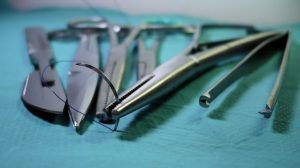Dysphagia – Episode 113
Dysphagia Basics
Having difficulty swallowing or the inability to swallow is known as dysphagia.
Symptoms of dysphagia include:
- Pain while swallowing
- The sensation of food stuck in the throat or chest
- Drooling
- Hoarseness
- Regurgitation
- Reflux
- Unexpected weight loss
- Choking, coughing, or gagging when swallowing
- Taking tiny bites
Dysphagia by Phase
There are several conditions that can affect each phase of the swallowing process.
Oral Phase
Dysphagia during the oral phase, or voluntary phase, can be caused by neurological conditions like Multiple Sclerosis, Muscular Dystrophy, advanced Parkinson’s. Brain damage caused by trauma or stroke can also cause trouble swallowing in adults.
Dysphagia in Kids
Babies start out nursing or feeding through a bottle and their swallowing mechanism is reversed. A reverse swallow is when the tongue is thrust forward or out of the mouth to open the throat and allow food or drink down the esophagus. As children learn to eat solid food and drink from a cup, the swallowing procedure changes. Children can also have trouble swallowing, but the root causes are completely different. Premature birth, low birth weight, cleft lip or palate, and tongue or lip ties can lead to swallowing issues if not corrected with therapy. These issues can cause swallowing issues with the reverse mechanism as well as make it difficult to convert to a regular swallow. Children with low muscle tone are also more likely to stick with the reverse swallow because it is easier.
Pharyngeal Phase
Pharyngeal diverticula are pouches that form in the mucous membrane above the esophagus. These pouches can collect food particles that don’t get swallowed. This can cause bad breath, as well as coughing, and constant throat-clearing because it feels like something is stuck in the throat.
Esophageal Phase
There are several swallowing issues that stem from the esophagus and esophageal phase.
- Achalasia is an issue where the sphincter that opens into the stomach doesn’t relax to allow food to pass through. This can cause pressure in the chest and may possibly lead to regurgitation if it persists.
- Diffuse spasms happen when the peristalsis rhythm of the esophagus muscles is poorly coordinated.
- Stricture is also known as a narrowed esophagus. It can be a result of injury and scarring from GERD.
- An esophageal ring is when a thin area of the lower esophagus is narrowed. This is also a result of scar tissue from chronic GERD. The scar tissue from acid damage tends to be less flexible which can cause pain.
- Eosinophilic esophagitis is the overpopulation of eosinophils in the esophageal lining due to food allergies. Eosinophils are a type of white blood cells that show up in very specific situations – parasitic infections, cancer, or allergies.
Dysphagia Risk
The risk of dysphagia increases with age, mostly because the risk of the conditions that cause dysphagia increases with age as well. And while dysphagia can be very uncomfortable, the biggest concern is with the risk of aspiration, or breathing food or drink into the lungs, that leads to pneumonia.
Call Back
Swallowing
Muscle Tone discussion – Accordion in Your Brain
Connect with me
Support us on Patreon
Join the Pharmacist Answers Podcast Community on Facebook
Subscribe: iTunes, Stitcher, GooglePlay, TuneIn Radio
Music Credits: Up In My Jam (All Of A Sudden) by – Kubbi https://soundcloud.com/kubbiCreative Commons — Attribution-ShareAlike 3.0 Unported— CC BY-SA 3.0 http://creativecommons.org/licenses/b…Music provided by Audio Library https://youtu.be/tDexBj46oNI



